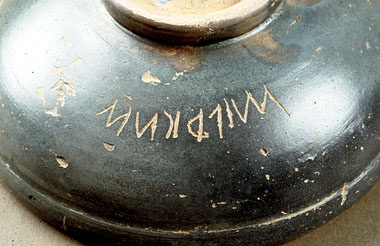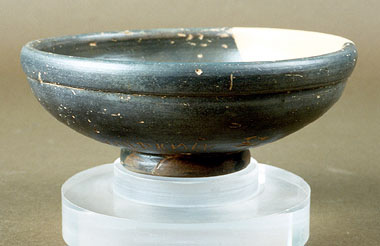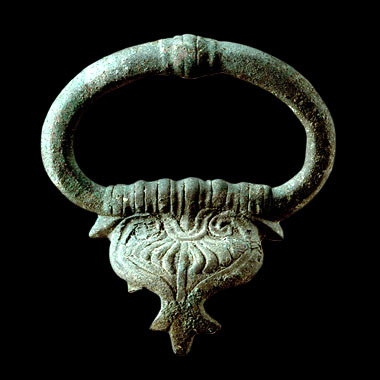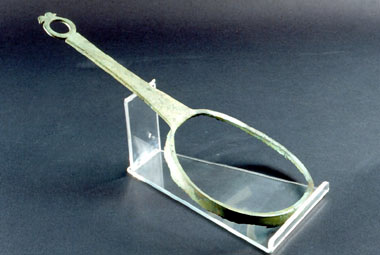Ponte a Moriano

Information
Recommended season:
All the season
Contacts:
National museum of Villa Guinigi
Era:
V century b.C.; III-II century b.C.
District/Location:
Lucca
District:
Piana di Lucca

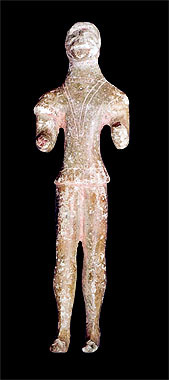
The final portion of the middle Serchio valley, before it opens towards the vast plain of Lucca where the river slackens its pace, narrows in the gorge of Ponte a Moriano, enclosed to the east by the Pizzorne and to the west by the hills of Moriano, outermost ramification of the Apuan Alps.
The area of Ponte a Moriano is of particular archaeological interest, known for its numerous findings since the end of the XIXth century. Discovered at different times and quite by chance, they show that the site was frequented for a long time in antiquity and certainly represented an important passage along the river.
In 1890, during railway construction works, a burial area was discovered; of the numerous finds, that were later scattered, a few are still preserved today. Two Etruscan bronzes were found in 1925 near the church of S. Gimignano. In 1971, once again in the area of S. Gimignano, objects belonging to one or more tombs came to light.
(text by SUSANNA BIANCHINI)
The area of Ponte a Moriano is of particular archaeological interest, known for its numerous findings since the end of the XIXth century. Discovered at different times and quite by chance, they show that the site was frequented for a long time in antiquity and certainly represented an important passage along the river.
In 1890, during railway construction works, a burial area was discovered; of the numerous finds, that were later scattered, a few are still preserved today. Two Etruscan bronzes were found in 1925 near the church of S. Gimignano. In 1971, once again in the area of S. Gimignano, objects belonging to one or more tombs came to light.
(text by SUSANNA BIANCHINI)
Ponte a Moriano
Remains not visible.; finds are on display at the National Museum of Villa Guinigi in Lucca.
The two bronzes found in 1925 together with a large stone carrying graffiti of dubious interpretation, represent a male god with helmet and armour and a the figure of a woman clad in a mantle. Dated to the Vth century B.C. and with an evident votive character, they prove the existence of an Etruscan cult centre near Ponte a Moriano, probably in connection with the route that, along the Serchio valley, reached the Apennine passes and the Etruscan area of the Po plain. It is likely that during this period, when other small Etruscan settlements in the middle and upper Serchio valley (Buca di Castelvenere) represented stops on the transapennine routes, there was a settlement also at Ponte a Moriano, nodal point in the connection across the plain of Lucca with the Etruscan centres of Pisa and Volterra.
The Etruscan occupation is certainly documented for the following period, when the Ligurian invasion of the mountainous regions of the Serchio valley (Monte Pisone; Colle delle Carbonaie; Castelvecchio Pascoli; Pietra Pertusa) completely disrupted the settlement pattern.
The findings of the 70's, dated between the end of the IVth and the IIIrd century B.C., consist of a homogeneous set of objects, maybe belonging to a single tomb, that of a man and quite rich: along with the black glazed pottery, we find bronze jars, a knife and an iron spearhead. Particularly important are three black glazed cups, each carrying on the outside an inscription in Etruscan characters with the family name percna, referring to their owner.
In addition to "cippo a clava" gravestone, black glazed pottery datable to the IIIrd century B.C. also appears among the findings of the end of the 19th century, confirming the presence near Ponte a Moriano of an Etruscan settlement. An this time the settlement, that marks the northernmost limit of Etruscan penetration, must have been important not only for defensive and strategic reasons, but also as a trading post with the Apuan Ligurians, who in turn controlled it from their high settlement of Pietra Pertusa.
Part of the 1890 finds, instead, are datable to the IInd century B.C., straight after the foundation of the colony of Lucca and present remarkable analogies to the small Ligurian necropolis of Marlia: besides the type of cinerary vessel, consisting of an olla of impasto covered by a black glazed cup, we find the same particular use of burial inside an amphora cut in half. It is possible that during the reorganization of the territory in Roman times a small group of Ligurians, already reduced to peace, was settled near Ponte a Moriano, on the edge of the colonized plain guarding the river course.
bibliography:
- Maggiani A., Pisa, Spina, ed un passo controverso dello Pseudo Scilace, in La Romagna fra VI e IV secolo a.C., Bologna 1987
- Ciampoltrini G., Aspetti dell'insediamento etrusco nella valle del Serchio: il V sec. a.C., in "Studi Etruschi" LIX, 1994
- Ciampoltrini G., Zecchini M., Un insediamento etrusco di età ellenistica sul versante lucchese, in Paribeni E. (a cura di), Etruscorum ante quam ligurum. La Versilia tra VII e III sec. a.C., Pontedera 1990.
- Maggiani A., Ager Lucensis: Ponte a Moriano, in Studi Etruschi 41, 1973
- Ciampoltrini G., I cippi funerari della bassa e media Valdera, in Prospettiva 21, 1980
The Etruscan occupation is certainly documented for the following period, when the Ligurian invasion of the mountainous regions of the Serchio valley (Monte Pisone; Colle delle Carbonaie; Castelvecchio Pascoli; Pietra Pertusa) completely disrupted the settlement pattern.
The findings of the 70's, dated between the end of the IVth and the IIIrd century B.C., consist of a homogeneous set of objects, maybe belonging to a single tomb, that of a man and quite rich: along with the black glazed pottery, we find bronze jars, a knife and an iron spearhead. Particularly important are three black glazed cups, each carrying on the outside an inscription in Etruscan characters with the family name percna, referring to their owner.
In addition to "cippo a clava" gravestone, black glazed pottery datable to the IIIrd century B.C. also appears among the findings of the end of the 19th century, confirming the presence near Ponte a Moriano of an Etruscan settlement. An this time the settlement, that marks the northernmost limit of Etruscan penetration, must have been important not only for defensive and strategic reasons, but also as a trading post with the Apuan Ligurians, who in turn controlled it from their high settlement of Pietra Pertusa.
Part of the 1890 finds, instead, are datable to the IInd century B.C., straight after the foundation of the colony of Lucca and present remarkable analogies to the small Ligurian necropolis of Marlia: besides the type of cinerary vessel, consisting of an olla of impasto covered by a black glazed cup, we find the same particular use of burial inside an amphora cut in half. It is possible that during the reorganization of the territory in Roman times a small group of Ligurians, already reduced to peace, was settled near Ponte a Moriano, on the edge of the colonized plain guarding the river course.
bibliography:
- Maggiani A., Pisa, Spina, ed un passo controverso dello Pseudo Scilace, in La Romagna fra VI e IV secolo a.C., Bologna 1987
- Ciampoltrini G., Aspetti dell'insediamento etrusco nella valle del Serchio: il V sec. a.C., in "Studi Etruschi" LIX, 1994
- Ciampoltrini G., Zecchini M., Un insediamento etrusco di età ellenistica sul versante lucchese, in Paribeni E. (a cura di), Etruscorum ante quam ligurum. La Versilia tra VII e III sec. a.C., Pontedera 1990.
- Maggiani A., Ager Lucensis: Ponte a Moriano, in Studi Etruschi 41, 1973
- Ciampoltrini G., I cippi funerari della bassa e media Valdera, in Prospettiva 21, 1980
- MAGGIANI A., Pisa, Spina, ed un passo controverso dello Pseudo Scilace, in La Romagna fra VI e IV secolo a.C., Bologna 1987
- CIAMPOLTRINI G., Aspetti dell'insediamento etrusco nella valle del Serchio: il V sec. a.C., in "Studi Etruschi" LIX, 1994
- CIAMPOLTRINI G., ZECCHINI M., Un insediamento etrusco di età ellenistica sul versante lucchese, in Paribeni E. (a cura di), Etruscorum ante quam ligurum. La Versilia tra VII e III sec. a.C., Pontedera 1990.
- MAGGIANI A, Ager Lucensis: Ponte a Moriano, in Studi Etruschi 41, 1973
- CIAMPOLTRINI G., I cippi funerari della bassa e media Valdera, in Prospettiva 21, 1980
Scopri altre attrazioni vicino a Ponte a Moriano
See allYou may also like..
See all
0








